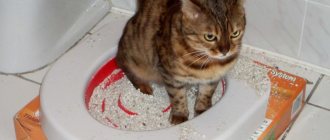Home » Useful Information
How to train a kitten to go to the litter box? Very simple!
You will need to set aside a little time, be patient and take into account the important advice of veterinarians.
The result will be achieved quickly if you simultaneously take into account the pet’s character and start the training process on time.
When a fluffy ball appears in the house, all family members are filled with a feeling of joy.
But immediately after a small puddle and other not-so-fragrant “traces of a crime” are discovered in one of the corners, euphoria gives way to disappointment, and sometimes even irritation.
And to prevent this from happening in the future, it is enough to know how to teach a kitten to go to the litter box. All it takes is a little patience, time and attention.
In fact, it's quite easy to instill good manners in him.
- 2 Tray selection
- 3 Space for tray
- 4 Training - basics
- 5 Express method
It all starts with the breeder
How to train a Scottish kitten to use the litter box? In general, the breeder should do this before the baby moves to a new home. Owners adopt a kitten when it reaches 2-2.5 months, by which time the pet is litter box trained. At least that's what the ideal option looks like.
In life, things happen differently; a kitten is bought before 2 months of age. Often he is barely 1-1.5 months old when the baby is separated from his mother. Such a baby does not yet have the skills to use the tray independently. How to accustom a Scottish kitten to the litter box if he arrived at his new home when he was very young? There are several methods, which are described below.
At what age should you train a kitten?
Kittens learn new skills from birth, although this is not always noticeable to the owner. Born blind and deaf, kittens can only rely on the smell and purring of their mother. When babies open their eyes, they actively explore the world, imitate their mother and obey her in everything.
If your pet was orphaned for some reason and you fed him artificially, he will quickly learn the rules of living together with people, but he will acquire typical cat habits more slowly.
Selecting a tray and filler
This subsection is short but informative. It will be useful for those who are getting a kitten for the first time.
When purchasing a tray, you should pay attention to tanks with high sides. They are good because the filler does not scatter in all directions when the pet carefully buries its waste. An excellent option would be a closed tray made in the shape of a house. These cat litter boxes are equipped with a special door so that your pet feels comfortable while in them. At first, when the kitten is small, the door can be removed.
As for the filler, many owners of “Scots” actively use silica gel. They absorb liquid well, forming small lumps that are convenient for cleaning. The package is enough for a month if you keep one cat.
How to stop shitting around the apartment?
The British favorite begins to play dirty tricks out of a feeling of discontent or revenge. First you need to find the root of the problem. So, if a cat has become accustomed to pooping in a corner or on the bed, then most likely the pet does not like the tray or litter. Replacing these two components will solve the problem. Lavender and lemon oil will also help you stop walking on furniture. It is recommended to apply a couple of drops to the headboard and backs of sofas or beds, and the pungent smell will scare cats away from the wrong place.
When a pet refuses to go to the toilet, but every time tries to find a secluded corner and hide its “goods” far away, it means that it is frightened by noises or other people’s looks at the litter box. Purchasing a toilet with a roof, in the form of a house, will be a good option. This behavior is also provoked by a lack of attention from the owner. You need to regularly play and communicate with your pet. And if he goes to the wrong place, you can scold the animal, but not beat him. Otherwise, his motives will be revenge.
Source
Ways to teach cleanliness
How to train a Scottish kitten to use the litter box (female, 2 months old)? Questions like this are very common on cat lovers forums. Newbie owners try to indicate not only the age, but also the gender of their pet.
Toilet training does not depend on the gender of the kitten. The basic rules that contribute to the speedy development of the reservoir are as follows:
- Choosing a temporary location for the tray.
- First acquaintance with him.
- Installing the tank in a permanent place.
- Carefully monitor your pet. As soon as he decides to go to the toilet, the kitten is carried into the tray.
Let's look at each point in detail.
Choosing a temporary location
When a kitten arrives in a new home, it is limited in space. The fact is that the fluffy new baby is too small to immediately remember where the bowl of food, bed or tray is. How to train a Scottish kitten to use the litter box at 2 months? Detailed instructions for the reader:
- Before bringing your pet to your apartment, arrange a place for him to live. One room should contain a bed (house), bowls of food and water, and a cat litter box.
- The baby arrived to new owners. He is introduced to a designated corner in which there is a tray, shown a place to rest, a bowl of food.
- By the time the kitten is introduced to it, there should be filler in the poop container.
In the first 3-4 weeks, while the baby gets used to the new place of residence and gets comfortable, the tray is located not far from the bed and bowls. If you put food in the kitchen and a toilet in a certain room, your pet will get confused and won’t be able to find it.
Installing the tray in a permanent place
Just as described above, you can train a Scottish kitten to use a litter box at 1.5 months. This method is universal, suitable for animals under 3 months of age.
The pet is getting older and has settled into the apartment perfectly. It's time to move the tray into the toilet room and show the four-legged prankster where he now needs to go about his “business”.
The place for the tray is chosen in such a way that the kitten does not have to look for it for a long time. Due to his age, the baby is not always able to control his needs. You can’t scold him for this, just like you can’t rub your nose into the misunderstanding on the floor. The baby will not understand what he has done wrong, he will get scared and stop trusting the owner.
If the baby does not make it to the tray, his excrement is collected using toilet paper and taken to the right place. After putting the scented paper in the tray, the kitten is placed there too. The new location of the tray will be remembered by the pet, he will begin to rush there, as soon as he feels the urge of the body to do this or that thing.
Step-by-step instruction
Time to move on to the basic instructions, by following which you can teach your kitten a new, very useful habit - going to the toilet in the tray.
- Place the litter in a quiet and secluded area of your home. This should not be a passage or corridor, or areas near doors where people often walk. The ideal place is a bathroom or toilet, which is always open and the cat has access to the litter around the clock.
- The best time for the first trip to the new toilet will be 20-40 minutes after the kitten eats. Take it and place it with its paws directly into the tray with the filler.
- Pet him, say something kind, and then move away and let him look around and sniff the new place.
- If the kitten is ready, it will do all the necessary things. After the procedure is completely completed, praise him and cover the waste with a fresh layer of filler. Disposal of waste should not be done due to the importance of the smell of waste in the toilet area. Cats sense this smell and it is easier for them to find a place to go to the toilet. However, you cannot leave the toilet completely untouched. Kittens and adult cats are very picky about cleanliness and will not go into a dirty litter box.
Important!
Don't be too aggressive with the kitten. If you are unable to train him to use the litter box and he goes to the toilet in the wrong places, you should show him your dissatisfaction, but in an extremely friendly manner. At the moment of a mistake, go up to the kitten, lightly tap his nose with your finger and tell him what he is wrong about (this is how cats let their kittens know that they are wrong). And then take him to the tray and gently explain that this is where he needs to go to the toilet.
If the cat went past the toilet more than an hour ago, do not scold him, this will cause him misunderstanding. He won't remember what he did wrong. It is necessary to make it clear in a timely manner about the mistake made, but as we wrote above, do this in an extremely friendly manner - without shouting or physical violence.
Tray training
This subsection describes how to litter box train a Scottish Fold kitten. There are several ways:
- When purchasing a pet, ask the breeder for some used litter.
- If you see that the baby has gone to the wrong place, follow the description in the previous subsection.
- When the pet begins to fuss and sit down, clearly intending to get rid of waste, he is picked up and quickly placed in a tank with filler.
- The old method from Soviet grandmothers-cat owners. Human urine is applied to a small strip of newspaper, plain paper, or toilet paper. It is placed in the cat's litter box and the pet is placed there as well. The smell will let him know that excrement is being disposed of in this place.
- The pet is placed in a tray with clean filler and given the opportunity to dig into it. It is believed that in this way the need to hide the waste of one’s life is awakened.
Tips and recommendations from a veterinarian: why the kitten suddenly stopped going to the litter box
When your pet went to the litter box normally and suddenly stopped, check the condition of the box. If the potty is clean, pay attention to your pet's behavior. Perhaps something startled him while he was emptying his crate. Fear is immediately visible; he may resist and refuse to move in the direction of the tray.
Other reasons why a cat may refuse to go into a box:
- Sexual instinct. If this is not a breeding animal, have your pet spayed/neutered. The operation will relieve many problems.
- Protest. For example, the pet does not want to sit at home on its own, or the owner does not pay attention to it.
- Unpleasant associations. Perhaps he was toilet trained using rough methods, punished, and now he is afraid of the litter box. Try buying a box of a different shape and changing the filling. Don't forget to express delight when the kitten defecates in the box.
Among the reasons why puddles and feces began to appear outside the tray are urinary tract infections and worms. To notice the problem in time, talk to your veterinarian and get tested.
Possible problems
Options for teaching a Scottish kitten to go to the litter box are described above. However, it also happens that the owner has tried all the methods, but the pet categorically refuses to visit the “thoughtful corner.” Let's consider the possible reasons for this behavior and methods for eliminating them:
- Plastic smell from the tray. A person is not able to catch it, the animal reacts very sensitively. On cat lovers' forums, you can often find posts about how your pet runs away from the litter box like it's on fire. Especially when the tank is cheap and made in China. What should the owner do in such a case? How to train a Scottish kitten to use the litter box? Wash the tank with hot water and soap several times, rinse and let dry. If this method does not help, then you will have to change the cat litter.
- Bad filler, the kitten prefers the more familiar one. The owner thinks that sawdust for the cat litter box is a decent option. It's cheap, the consumption is small, it absorbs the smell - what else do you need? It turns out that the purebred pet has his own view on this issue. Living with a breeder, he got used to stony litter, sand or silica gel. It is useless to convince your pet, because then fragrant piles will be found in places that are completely unsuitable for these purposes. It’s easier to change the filler and forget about the problem.
- How to train a Scottish kitten to use a litter box if the animal does not like its location. There are also whims when a representative of the breed chooses another corner to suit his needs, ignoring the tank with filler. The problem can be easily solved if the tray is moved to the selected location.
Frequent difficulties
The reason for not going to the litter box may be its color or shape.
Raising a British pet is not easy, especially if a person is experiencing it for the first time. There are a number of difficulties that owners of luxury pets often face. It happens that a stubborn cat has chosen another place for his toilet and flatly refuses to relieve his needs in the tray. In this case, there are two options to solve the problem. Firstly, the owner can make concessions: put the tray in a favorite place. But if such a rearrangement is impossible, then block access to this place for the cat. It happens that the cat simply does not like this tray. He may remind her of something unpleasant. Then only buying a new toilet can help. If this applies specifically to the filler, then it is worth replacing it.










